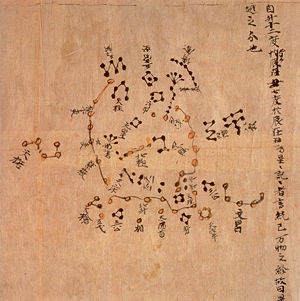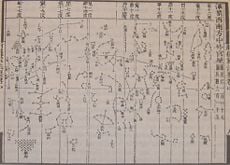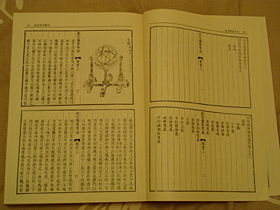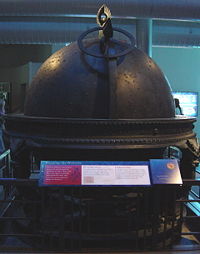Chinese astronomy
Template:Expert-portal
| This article contains Chinese text. Without proper rendering support, you may see question marks, boxes, or other symbols instead of Chinese characters. |

Astronomy in China has a very long history. Oracle bones from the Shang Dynasty (2nd millennium B.C.E.) record eclipses and novae. Detailed records of astronomical observations were kept from about the 6th century B.C.E. until the introduction of Western astronomy and the telescope in the 16th century. The practice of astronomy in China was fundamentally changed by extended contact with Western astronomy. Today, China continues to be active in astronomy, with many observatories and its own space program.
Early history
Purpose of astronomical observations in the past
One of the main functions was for the purpose of timekeeping. The Chinese used a lunisolar calendar , but because the cycles of the Sun and the Moon are different, intercalation had to be done.
The Chinese calendar was considered to be symbol of a dynasty. As dynasties would rise and fall, astronomers and astrologers of each period would often prepare a new calendar to be made, with observations for that purpose.
Astrological divination was also an important part of astronomy. Astronomers took careful note of "guest stars" which suddenly appeared among the fixed stars. The supernova that created the Crab Nebula in 1054 is an example of a guest star observed by Chinese astronomers, recorded also by the Arabs, although it was not recorded by their European contemporaries. Ancient astronomical records of phenomena like supernovae and comets are sometimes used in modern astronomical studies.
Chinese constellations
History of Chinese constellations
The divisions of the sky began with the Northern Dipper and the 28 mansions.
In early 1980s, a tomb was found at Xi Shui Po (西水坡) in Pu Yang, Henan Province. There were some clamshells and bones forming the images of the Azure Dragon, the White Tiger and the Northern Dipper. It is believed that the tomb belongs to the Neolithic Age, about 6,000 years ago.
Star names relating to the 28 lunar mansions were found on oracle bones dating back to the Wuding Period, about 3,200 years ago.
In 1978, a lacquer box was excavated from the tomb of Zeng Hou Yin in Suixian, Hubei Province. Names of the 28 lunar missions were found on the cover of the box, proofing that the use of this classification system was made before 433 B.C.E.
As lunar mansions have such an ancient origin, the meaning of most of their names have become obscure. Even worse, name of each lunar mansion consists of only one Chinese word, and the meaning of which could vary at different times in history. So the meaning of the names are sill under discussion.
Besides 28 lunar mansions, most constellations are based on the works of Shi Shen-fu and Gan De, who were astrologists during the period of Warring States (481 B.C.E. - 221 B.C.E.) in China.
In the late period of the Ming Dynasty, the agricultural scientist and mathematician Xu Guangqi (1562 - 1633 C.E.) introduced 23 additional constellations which are near to the Celestial South Pole, which are based on star catalogues from the West (see Matteo Ricci).
Classification
Unlike the West, where the starry sky is a pantheon of Greek legendary hero and mystic creatures, the Chinese treat the heavens as a miniature of their earthly world, a reflection of their feudal society.
Star catalogues and Maps
Star catalogues
Before the Greek Hipparchus created the first star catalogue of the Western world during the 2nd century B.C.E., the 4th century B.C.E. astronomers Shi Shen and Gan De were the first in history to compile a star catalogue. Publishings of the two were known as Star Manual of Masters Gan and Shi (甘石星經), the world's first star catalogue. Although this catalogue in full was eventually lost over the centuries, luckily part of its content was referred to and used by other Chinese documents such as Treatise on Astrology in the Kaiyuan Regin (開元占經) during the reign of Emperor Xuanzong of Tang (712 - 756 C.E.). After analyzing and providing summary on the work of Gan De and Shi Shen, Tang era astronomers mentioned the names of more than 800 stars that were found, 121 of them marked with positions. [1]
Another Chinese classic is the Star Manual of Master Wuxian (巫咸星經). Its authorship is still in dispute because it mentioned names of Twelve Countries, which did not exist in the Shang Dynasty, the era of which it was supposed to have been written. Moverover, it was customary in the past for the Chinese to forge works of notable scholars, as this could lead to a possible explanation for the inconsistencies found.
The Han Dynasty astronomer and inventor Zhang Heng (78 - 139 C.E.) not only catalogued some 2500 different stars, but also recognized over 100 different constellations. Zhang Heng also published his work Ling Xian, a summary of different astronomical theories in China at the time. In subsequent period of the Three Kingdoms (220 - 280 C.E.), Chen Zhuo (陳卓) combined the work of his predecessors, forming another star catalogue. This time 283 constellations and 1464 stars were listed. The astronomer Guo Shoujin of the Yuan Dynasty (1279 - 1368 C.E.) created a new catalogue which was believed to contain thousands of stars. Unfortunately, many of documents at that period were destroyed, including that of Shoujin. Imperial Astronomical Instruments (儀象考成) published in 1757 containing 3083 stars exactly.
Star maps

The Chinese drew many maps of stars in the past centuries, yet the oldest existent star map in printed form is from Su Song's (1020-1101 C.E.) celestial atlas of 1092 C.E., which was included in the horological treatise on his clocktower. The most famous one is perhaps the map found in Dunhuang, Gansu. Uncovered by the British archaeologist Marc Aurel Stein in 1907, the star map was brought to the British Museum in London.
The map was drawn on paper and represents the complete sky with more than 1,350 stars. Though ancient Babylonians and Greeks also observed the sky and catalogued stars, no such complete record of the stars may exist or survive. Hence this is the oldest chart of the actual skies in the present.
Stars appearing on the chart were marked with three colors: black for the stars of Gan, yellow for the stars of Shi, and white fore the stars of Wuxian.
According to recently studies, the map may date the manuscript to as early as the 7th century AD (Tang Dynasty). Scholars believe the star map dating from 705 to 710 C.E., which is the reign of Emperor Zhongzong of Tang. Some experts from the West think the chart may be a copy of an earlier existing document. There are some texts (Monthly Ordinances, 月令) describing the movement of the sun among the sky each month, which was not based on the observation at that time.
Lunar and solar eclipses
The ancient Chinese astronomer Shi Shen (fl. 4th century B.C.E.) was aware of the relation of the moon in a solar eclipse, as he provided instructions in his writing to predict them by using the relative positions of the moon and sun.[1] The 'radiating influence' theory for a solar eclipse was opposed by the Chinese philosopher Wang Chong (27-97 C.E.), but he admits in his writing that it was nothing new. The Chinese astronomer and inventor Zhang Heng (78-139 C.E.) wrote of both solar eclipse and lunar eclipse in the publication of Ling Xian (靈憲), 120 C.E. (Wade-Giles):
The sun is like fire and the moon like water. The fire gives out light and the water reflects it. Thus the moon's brightness is produced from the radiance of the sun, and the moon's darkness (pho) is due to (the light of) the sun being obstructed (pi). The side which faces the sun is fully lit, and the side which is away from it is dark. The planets (as well as the moon) have the nature of water and reflect light. The light pouring forth from the sun (tang jih chih chhung kuang) does not always reach the moon owing to the obstruction (pi) of the earth itself—this is called 'an-hsü', a lunar eclipse. When (a similar effect) happens with a planet (we call it) an occulation (hsing wei); when the moon passes across (kuo) (the sun's path) then there is a solar eclipse (shih).[2]
Furthermore, the later Chinese scientist Shen Kuo (1031-1095) used the models of lunar eclipse and solar eclipse in order to prove that the celestial bodies were round, not flat (which promoted spherical earth theory and went against flat earth theory). He wrote of this in his Dream Pool Essays of 1088 C.E., relating back when the Director of the Astronomical Observatory had asked Shen if the shapes of the sun and moon were round like balls or flat like fans. Shen Kuo explained his reasoning for the former:
If they were like balls they would surely obstruct each other when they met. I replied that these celestial bodies were certainly like balls. How do we know this? By the waxing and waning of the moon. The moon itself gives forth no light, but is like a ball of silver; the light is the light of the sun (reflected). When the brightness is first seen, the sun (-light passes almost) alongside, so the side only is illuminated and looks like a crescent. When the sun gradually gets further away, the light shines slanting, and the moon is full, round like a bullet. If half of a sphere is covered with (white) powder and looked at from the side, the covered part will look like a crescent; if looked at from the front, it will appear round. Thus we know that the celestial bodies are spherical.[3]
When he asked Shen Kuo why eclipses occurred only on an occasional basis while in conjunction and opposition once a day, Shen Kuo wrote:
I answered that the ecliptic and the moon's path are like two rings, lying one over the other, but distant by a small amount. (If this obliquity did not exist), the sun would be eclipsed whenever the two bodies were in conjunction, and the moon would be eclipsed whenever they were exactly in position. But (in fact) though they may occupy the same degree, the two paths are not (always) near (each other), and so naturally the bodies do not (intrude) upon one another.[3]
Equipment and innovation
Armillary sphere (渾儀)

The earliest development of the armillary sphere in China goes back to the astronomers Shi Shen and Gan De in the 4th century B.C.E., as they were equipped with a primitive single-ring armillary instrument.[4] This would have allowed them to measure the north polar distance (去極度, the Chinese form of declination) and measurement that gave the position in a hsiu (入宿度, the Chinese form of right ascension).[4]
During the Western Han Dynasty (202 B.C.E. - 9 C.E.) additional developments made by the astronomers Luo-xia Hong (落下閎), Xiangyu Wang-ren, and Geng Shou-chang (耿壽昌) advanced the use of the armillary in its early stage of evolution. In 52 B.C.E., it was the astronomer Geng Shou-chang who introduced the first permanently fixed equatorial ring of the armillary sphere.[4] In the subsequent Eastern Han Dynasty ( 23-220 C.E.) period, the astronomers Fu An and Jia Kui added the elliptical ring by 84 C.E.[4] With the famous statesman, astronomer, and inventor Zhang Heng (78-139 C.E.), the sphere was totally complete in 125 C.E., with horizon and meridian rings.[4] It is of great importance to note that the world's first hydraulic (i.e. water-powered) armillary sphere was created by Zhang Heng, who operated his by use of an inflow clepsydra clock (see Zhang's article for more detail).
Abridged armilla (簡儀)
Designed by famous astronomers Guo Shoujing in 1276 C.E., it solved most problems found in armillary spheres at that time.
The primary structure of Abridged Armilla contains two large rings that are perpendicular to each other, of which one is parallel with the equatorial plane and is accordingly called “equatorial ring”, and the other is a double-ring which is perpendicular to the center of the equatorial ring, revolves around a metallic shaft, and is called “right ascension double-ring”.
The double-ring holds within itself a sighting tube with crosshairs. When observing, astronomers aim the star with the sighting tube, stars’ position can be read out at the dials of the equatorial ring and the right ascension double-ring.
A foreign missionary melted the instrument in 1715 C.E. The survived one was built in 1437 C.E., and was taken by Germany and stored in France Embassy in 1990 during Eight-Nation Alliance. Under the pressure of international public voice the German returned it to China. In 1933 it was placed in Purple Mountain Observatory for preventing it being destroy in war. In the 1980s it had already been eroded seriously and was nearly destroy. To deal with it Nanjing government spent 11 months to repair it.
Celestial globe (渾象) before Qing Dynasty

Besides star maps, the Chinese also make Celestial globes, which show stars position liked a star map and can present the actual sky in a specific time. Because of its Chinese name, the Chinese always make it up with Armillary sphere, which is just one word different (渾象 vs. 渾儀).
According to records, the first Celestial globe was made by Geng Shou-chang (耿壽昌) between 70B.C.E. and 50B.C.E. In Ming Dynasty, celestial globe at that time was a huge globe, showing with the 28 mansions, celestial equator and ecliptic. But just like many other equipment, none of them survived.
Celestial globe (天體儀) in Qing Dynasty
Celestial globe was named 天體儀 in Qing Dynasty. The one in Beijing Ancient Observatory was made by Belgian missionary Ferdinand Verbiest (南懷仁) 1673 C.E. Unlike other Chinese celestial globes, it employs 360 degrees rather than the 365.24 degrees (which is a standard in ancient China). It is also the Chinese-first globe which shows constellations near to the Celestial South Pole.
The Water-powered Armillary Sphere and Celestial Globe Tower (水運儀象台)
The first to invent the hydraulic-powered armillary sphere was Zhang Heng (78-139 C.E.) of the Han Dynasty. Zhang was well-known for his brilliant applications of mechanical gears, as this was one of his most impressive inventions (alongside his seismograph to detect the cardinal direction of earthquakes that struck hundreds of miles away).
Started by Su Song (蘇頌) and his colleagues in 1086 C.E. and finished in 1092 C.E., his large astronomical clock tower featured an armillary sphere (渾儀), a celestial globe (渾象) and a mechanical chronograph. It was operated by an escapement mechanism and the earliest known chain drive. However 35 years later the invading Jurchen army dismantled the tower in 1127 C.E. upon taking the capital of Kaifeng. The armillary sphere part was brought to Beijing, yet the tower was never successfully reinstated, not even by Su Song's son.
Fortunately two versions of Su Song’s treatise written on his clock tower have survived the ages, so that studying his astronomical clock tower is made possible through medieval texts.
True north and planetary motion
The polymath Chinese scientist Shen Kuo (1031-1095) was not only the first in history to describe the magnetic-needle compass, but also a more accurate measurement of the distance between the polestar and true north that could be used for navigation. Shen achieved this by making nightly astronomical observations along with his colleague Wei Pu, using Shen's improved design of a wider sighting tube that could be fixed to observe the polestar indefinitely. Along with the polestar, Shen Kuo and Wei Pu also established a project of nightly astronomical observation over a period of five successive years, an intensive work that would even rival the later work of Tycho Brahe in Europe. Shen Kuo and Wei Pu charted the exact coordinates of the planets on a star map for this project, and created theories of planetary motion, including retrogradation.
Observatory
- Beijing Ancient Observatory
- Astro Observatory
Jesuit activity in China
The introduction of Western science to China by Jesuit priest astronomers was a mixed blessing during the late 16th century and early 17th century.
Telescope was introduced to China in the early 17th century. The telescope was first mentioned in Chinese writing by Emanuel Diaz (Yang Ma-Nuo), who wrote his Tian Wen Lüe in 1615.[5] In 1626 Adam Schall von Bell (Tang Ruo-wang) published the Chinese treatise on the telescope known as the Yuan Jing Shuo (The Far-Seeing Optic Glass).[6] The Chongzhen Emperor (明思宗, 1627-1644) of the Ming Dynasty acquired the telescope of Johannes Terrentius (or Johann Schreck; Deng Yu-han) in 1634, ten years before the collapse of the Ming Dynasty.[5] However, the impact on Chinese astronomy was limited.
The Jesuit China missions of the 16th and 17th centuries brought Western astronomy, then undergoing its own revolution, to China. After the Galileo affair early in the 17th century, the Roman Catholic Jesuit order was required to adhere to geocentrism and ignore the heliocentric teachings of Copernicus and his followers, even though they were becoming standard in European astronomy.[7] Thus, the Jesuits shared an Earth-centered and largely pre-Copernican astronomy with their Chinese hosts (i.e. the inaccurate Ptolemaic-Aristotelian views from Hellenistic times).[7] The Chinese were often fundamentally opposed to this as well, since the Chinese had long believed (from the ancient doctrine of Xuan Ye) that the celestial bodies floated in a void of infinite space.[7] This contradicted the Aristotelian view of solid concentric crystalline spheres, where there was not a void, but a mass of air between the heavenly bodies.[7]
Of course, the views of Copernicus, Galileo, and Tycho Brahe would eventually triumph in European science, and these ideas slowly leaked into China despite Jesuit efforts to curb them in the beginning. In 1627, the Polish Jesuit Michael Boym (Bu Mi-ge) introduced Johannes Kepler's Copernican Rudolphine Tables with much enthusiasm to the Ming court at Beijing.[5] In Adam Schall von Bell's Chinese-written treatise of Western astronomy in 1640, the names of Copernicus (Ge-Bai-Ni), Galileo (Jia-li-lüe), and Tycho Brahe (Di-gu) were formally introduced to China.[8] There were also Jesuits in China who were in favor of the Copernican theory, such as Nicholas Smogulecki and Wenceslaus Kirwitzer.[5] However, Copernican views were not widespread or wholly accepted in China during this point. In Japan, the Dutch aided the Japanese with the first modern observatory of Japan in 1725, headed by Nakane Genkei, whose observatory of astronomers wholly accepted the Copernican view.[9] In contrast, the Copernican view was not accepted in mainstream China until the early 19th century, with the Protestant missionaries such as Joseph Edkins, Alex Wylie, and John Fryer.[9]
Modern astronomy
Famous Chinese astronomers
- Gan De
- Guo Shoujing
- Shen Kuo
- Shi Shen
- Su Song
- Xu Guangqi
- Zhang Heng
See also
- Book of Silk
- Chinese astrology
- Chinese constellation
- History of astronomy
- Timeline of Chinese astronomy
Notes
- ↑ Needham, Volume 3, 411.
- ↑ Needham, Volume 3, 414.
- ↑ 3.0 3.1 Needham, Volume 3, 415-416.
- ↑ 4.0 4.1 4.2 4.3 4.4 Needham, Volume 3, 343.
- ↑ 5.0 5.1 5.2 5.3 Needham, Volume 3, 444.
- ↑ Needham, Volume 3, 444-445.
- ↑ 7.0 7.1 7.2 7.3 Needham, Volume 3, 438-439.
- ↑ Needham, Volume 3, 445.
- ↑ 9.0 9.1 Needham, Volume 3, 447.
ReferencesISBN links support NWE through referral fees
- Needham, Joseph (1986). Science and Civilization in China: Volume 3. Taipei: Caves Books, Ltd.
Further reading
- Encyclopaedia of the History of Science, Technology, and Medicine in Non-Western Cultures, edited by Helaine Selin. Dordrecht: Kluwer, 1997. S.v. "Astronomy in China," by Ho Peng Yoke.
- Sun Xiaochun, "Crossing the Boundaries Between Heaven and Man: Astronomy in Ancient China," in Astronomy Across Cultures: The History of Non-Western Astronomy, edited by H. Selin, pp. 423-454. Dordrecht: Kluwer, 2000.
- Chan Ki-hung: Chinese Ancient Star Map, Leisure and Cultural Services Department, 2002, ISBN 962-7054-09-7
- Gems of the ancient Chinese astronomy relics, ISBN 962-7797-03-0
External links
- The Mathematics of the Chinese Calendary by Helmar Aslaksen
- Copernicus in China by Nathan Sivin
- Boundaries Crossing: Western Astronomy in Confucian China, 1600-1800 by Pingyi Chu
- Homepage of the National Astronomical Observatories, Chinese Academy of Sciences
- Chinese Ancient Astronomy
- Ancient Chinese Astronomy Exhibition
Credits
New World Encyclopedia writers and editors rewrote and completed the Wikipedia article in accordance with New World Encyclopedia standards. This article abides by terms of the Creative Commons CC-by-sa 3.0 License (CC-by-sa), which may be used and disseminated with proper attribution. Credit is due under the terms of this license that can reference both the New World Encyclopedia contributors and the selfless volunteer contributors of the Wikimedia Foundation. To cite this article click here for a list of acceptable citing formats.The history of earlier contributions by wikipedians is accessible to researchers here:
The history of this article since it was imported to New World Encyclopedia:
Note: Some restrictions may apply to use of individual images which are separately licensed.
